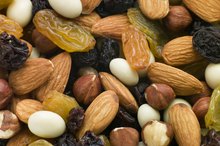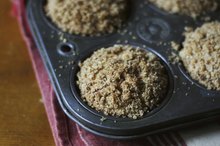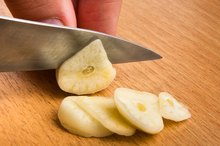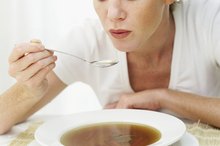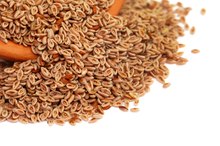Diverticulitis Diets for Diabetics
Diverticular disease is a condition where pouches are formed in the colon as a result of a low-fiber diet and/or lack of exercise. The two phases of diverticular disease are called diverticulosis and diverticulitis. Diverticulosis is the quiet phase with little to no symptoms. During this time, it is recommended to consume a high-fiber diet to maintain regular bowel movements. Diverticulitis is the active phase when the pouches become infected and/or inflamed, and is accompanied by pain. During this time, it is recommended to consume a low-fiber diet. Because a diet high in fiber is recommended for people with diabetes to help control blood glucose, the diet for diverticulitis can be quite challenging.
If you are experiencing serious medical symptoms, seek emergency treatment immediately.
Grains
People with diabetes should consume whole grains to help control blood glucose, according to the American Diabetic Association 3. However, during diverticulitis, it is recommended to replace whole grains with refined grains such as:
- white breads
- pasta
- rice,
- low-fiber cereals
Because these foods are high in carbohydrates and low in fiber, it is important for those with diabetes to closely monitor the portion sizes of these foods, and limit intake to 2 to 3 servings per meal. One serving is equal to 1 slice (1oz.) of bread, 1/3 cup cooked rice or pasta, and 3/4 cup low-fiber cereal.
- People with diabetes should consume whole grains to help control blood glucose, according to the American Diabetic Association 3.
- However, during diverticulitis, it is recommended to replace whole grains with refined grains such as: * white breads
* pasta
* rice,
* low-fiber cereals Because these foods are high in carbohydrates and low in fiber, it is important for those with diabetes to closely monitor the portion sizes of these foods, and limit intake to 2 to 3 servings per meal.
Fruits
Do Some Foods Aggravate Diverticulitis?
Learn More
During a flare of diverticulitis, raw fruits, fruits with skin and juices with pulp should all be avoided 1. It is recommended to replace these fruit options with canned fruits without skin and fruit juices without pulp. Both of these options are high in sugar and portion control is very important for people with diabetes. According to the American Diabetic Association, one serving is equal to 4 oz 23. of juice or 1/2 cup of canned fruit. It is extremely important to avoid fruits canned in heavy syrup, and instead, choose those canned in their own juices.
Vegetables
Like fruits, raw vegetables and vegetables with skins should be avoided during diverticulitis. Most vegetables contain only small amounts of carbohydrates. Exceptions are starchy vegetable such as potatoes, which are high in carbohydrates. During diverticulitis, it is OK to consume well-cooked potatoes without skins. For those with diabetes and diverticulitis, servings must be limited to 1/3 cup cooked potatoes per meal.
- Like fruits, raw vegetables and vegetables with skins should be avoided during diverticulitis.
- During diverticulitis, it is OK to consume well-cooked potatoes without skins.
Vitamins And Minerals
Colitis Diet Foods to Avoid
Learn More
Consuming foods low in fiber results in a diet deficient in many important vitamins and minerals. Therefore, it is recommended for all individuals with diverticulitis to have a daily multivitamin and mineral supplement 1. Supplementation should continue until symptoms have resolved and fiber can once again be consumed at the recommended 20 g to 35 g per day.
Related Articles
References
- Serovera AMP 500: All About Diverticulitis
- American Dietetic Association: Low-Fiber Nutrition Therapy
- American Dietetic Association: Carbohydrate Counting for People with Diabetes
- Barroso AO, Quigley EM. Diverticula and diverticulitis: time for a reappraisal. Gastroenterology & Hepatology. 2015;11(10):680-8.
- NIH National Institute of Diabetes and Digestive and Kidney Diseases. Eating, diet, & nutrition for diverticular disease. Updated May 2016.
- Harvard T.H. Chan. Carbohydrates and blood sugar.
- Today’s Dietician. Fiber & irritable bowel syndrome – strategies for counseling patients. Updated August 2016.
- Stanford Hospital & Clinics. Low fiber diet for diverticulitis. Updated January 2014.
- The Oregon Clinic. BRAT diet for nausea, vomiting, or diarrhea.
- Nallapeta NS, Foris LA, Tuma F, et al. Diverticulosis. In: StatPearls. Updated December 13, 2019.
- Carabotti M, Annibale B. Treatment of diverticular disease: an update on latest evidence and clinical implications. DIC. 2018;7:1-11. doi:10.7573/dic.212526
- University of California, San Francisco Health. Diverticular disease and diet.
- American Society of Colon and Rectal Surgeons. Diverticular disease expanded version.
- Rezapour M, Ali S, Stollman N. Diverticular disease: An update on pathogenesis and management. Gut Liver. 2018;12(2):125-132. doi:10.5009/gnl16552
- Strate LL, Keeley BR, Cao Y, Wu K, Giovannucci EL, Chan AT. Western dietary pattern increases, and prudent dietary pattern decreases, risk of incident diverticulitis in a prospective cohort study. Gastroenterology. 2017;152(5):1023-1030.e2. doi:10.1053/j.gastro.2016.12.038
- Dahl C, Crichton M, Jenkins J, et al. Evidence for dietary fibre modification in the recovery and prevention of reoccurrence of acute, uncomplicated diverticulitis: A systematic literature review. Nutrients. 2018; 10(2):137-. doi:10.3390/nu10020137
- Eglash A, Lane CH. What is the most beneficial diet for patients with diverticulosis? J Fam Pract. 2006 September;55(9):813-814.
- Office of Disease Prevention and Health Promotion. Dietary Guidelines 2015-2020.
- Barroso AO, Quigley EM. Diverticula and diverticulitis: time for a reappraisal. Gastroenterology & Hepatology. 2015;11(10):680-8.
- Strate LL, Morris AM. Epidemiology, pathophysiology, and treatment of diverticulitis. Gastroenterology. 2019;156(5):1282-1298.e1. doi:10.1053/j.gastro.2018.12.033
- Okawa Y, Fukudo S, Sanada H. Specific foods can reduce symptoms of irritable bowel syndrome and functional constipation: a review. BioPsychoSocial Med. 2019;13:10. doi:10.1186/s13030-019-0152-5
- NIH National Institute of Diabetes and Digestive and Kidney Diseases. Eating, diet, & nutrition for diverticular disease. Updated May 2016.
- HealthLink BC. Healthy eating guidelines for people with diverticular disease. Updated April 2019.
- Severi C, Carabotti M, Cicenia A, Pallotta L, Annibale B. Recent advances in understanding and managing diverticulitis. F1000 Res. 2018;7:971-. doi:10.12688/f1000research.14299.1
- Dashti HS, Mogensen KM. Recommending small, frequent meals in the clinical care of adults: a review of the evidence and important considerations. Nutr Clin Pract. 2016;32(3):365-377. doi:10.1177/0884533616662995
- Harvard T.H. Chan. Carbohydrates and blood sugar.
- Today’s Dietician. Fiber & irritable bowel syndrome – strategies for counseling patients. Updated August 2016.
- McRorie, JW. Evidence-based approach to fiber supplements and clinically meaningful health benefits, part 2. Nutrition Today. 2015;50(2):90-97. doi:10.1097/NT.0000000000000089
- Stanford Hospital & Clinics. Low fiber diet for diverticulitis. Updated January 2014.
- Abdullah MMH, Gyles CL, Marinangeli CPF, Carlberg JG, Jones PJH. Dietary fibre intakes and reduction in functional constipation rates among Canadian adults: a cost-of-illness analysis. Food & Nutrition Research. 2017;59(1):28646. doi:10.3402/fnr.v59.28646
- The Oregon Clinic. BRAT diet for nausea, vomiting, or diarrhea.
- Uno Y, Velkinburgh JCv. Logical hypothesis: low FODMAP diet to prevent diverticulitis. WJGPT. 2016;7(4):503-512. doi:10.4292/wjgpt.v7.i4.503
- Harvard Medical School Harvard Health Publishing. Diverticular disease prevention and treatment. Updated February 2011.
- Ünlü C, Daniels L, Vrouenraets B, Boermeester M. A systematic review of high-fibre dietary therapy in diverticular disease. Int J Colorectal Dis. 2011;27(4):419-427. doi:10.1007/s00384-011-1308-3
- Weir SBS, Akhondi H. Bland Diet. In:StatPearls. Updated March 9, 2019.
Writer Bio
Jennifer Martinez has been writing for the website Slimreviews.com since 2007, reviewing popular weight loss products, methods and literature. She earned her Bachelor of Science degree in nutrition from the University of New Mexico and completed her dietetic internship at the Medical College of Virginia. Martinez has been a registered dietitian since 2004. In 2005 she became a Clinical Nutrition Support Dietitian.
